According to HubSpot’s latest State of Marketing Report, producing and publishing content is the marketing strategy with the highest potential ROI in 2023. And not just because content marketing offers a great way to reach, engage, and convert audiences (as well as nurture loyalty).
But, more impressively, exceptional B2C content unlocks a natural way to capture audience attention, seeing that the average person spends 7 hours and 34 minutes (per day) consuming digital media.
Of course, ensuring content marketing success isn’t just about clicking the “Publish” button three to five times per week. Great results hugely depend on your capability to meet (and exceed) audience expectations. Semrush’s State of Content Marketing Report for 2023 found that well-conducted audience research ranks highest in terms of factors leading to positive results, followed by SEO, publishing more content, and boosting quality.
In other words, adapting your production and distribution methods to align with your audience’s needs is crucial for helping you reach the goals you’ve set for yourself.
With this in mind, planning your B2C content marketing tactics necessitates an in-depth understanding of what end-buyers want from brands during their shopping journeys. Behavior research from GWI suggests that the main ways for brands to win over consumers in 2023 and beyond include:
- Offering convenience through clarity and approachability.
- Attracting buyers with immersive and visual experiences.
- Giving access to exclusive content and services and going the extra mile in delivering a premium customer experience.
- Building credibility by collaborating with trustworthy brand ambassadors.
- Building one-on-one relationships with customers and personalizing their experiences to nurture loyalty.
So, if you’re ready to take your content game to the next level, here are the six principles that drive B2C content marketing success, along with tips on implementing them in your strategy.
Give Consumers a Reason to Return to Your Blog
One of the absolute best ways to drive B2C content marketing success is to focus most of your production efforts on creating valuable and unique articles. They will encourage your audience to continue returning to your blog repeatedly.
Even though repeat visits may not seem that important to you, remember — most people take brand familiarity and trust into consideration before making a purchasing decision. So, establishing your business as a credible, customer-oriented entity could be the key to securing conversions once your prospects have moved on to the bottom stages of the sales funnel.
The least resource-intensive way to achieve the needed familiarity and credibility is to create evergreen content and long-form articles. Because these posts cover topics in detail, target search terms related to consumer pain points, and offer information/advice/value that your audience can’t find elsewhere, they’re an excellent starting point for B2C content marketing success.
For example, data shows that one of the main reasons people go online is to find information. According to Statista, 60.1% of the world’s population uses the internet for informational purposes. With this in mind, it doesn’t come as a surprise that some of the highest-performing pieces of content are evergreen articles that answer common questions and remain relevant for long periods.
If you check out Beebom’s How to Speed Up Windows 11 and Improve Performance, you’ll see that it’s an insightful resource filled with tips and step-by-step instructions on achieving the desired effect. But it also includes screenshots of every process mentioned, resulting in a page that people are almost guaranteed to bookmark for continued visits (or at least remember visiting and searching for the next time they encounter a similar pain point).
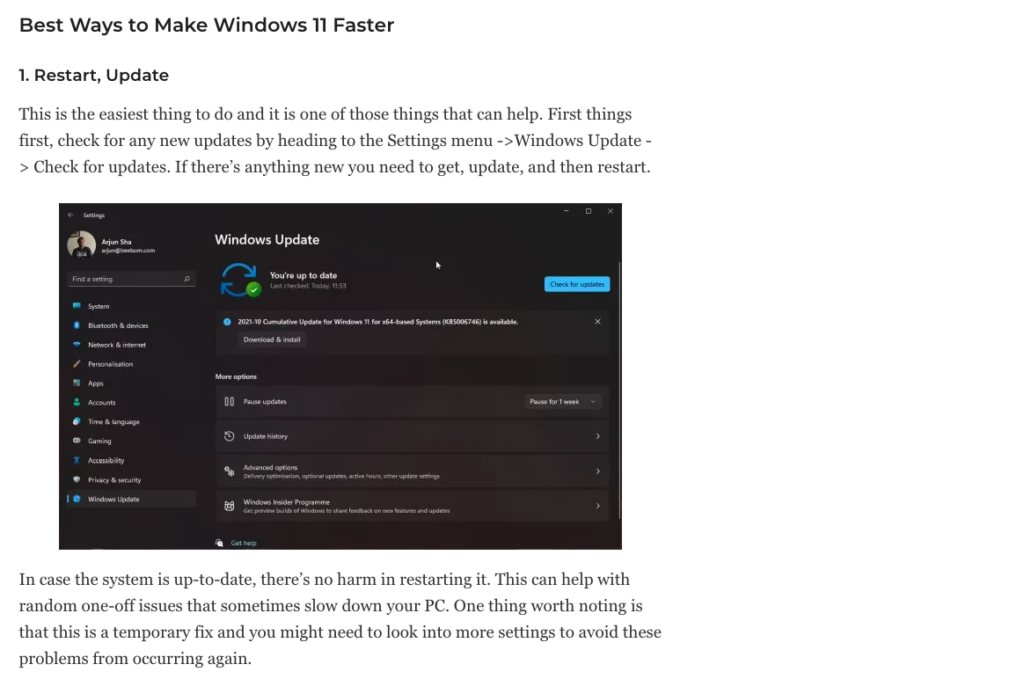
Source: beebom.com
Of course, giving consumers a reason to return to your blog doesn’t necessarily mean you should only focus on long-form, evergreen content.
Posts containing reference tables, infographics, tutorials, calculators, or any other informational tool you can imagine can be equally effective at ensuring return visits from your target audience.
For instance, knowing that end consumers rarely make big-ticket purchases on a whim, Shop Solar created a Watts, Volts, Amps Calculator. The tool is a great reference point for people starting their buyer’s journey toward going solar. But it’s also a valuable resource that most consumers will bookmark or remember and (most likely) visit again, ensuring that Shop Solar remains at the top of their minds for when they’re ready to buy.

Source: shopsolarkits.com
Intelligent Content Collaborations Can Generate Massive Credibility
Brand authority, trust, and reputation are critical to end consumers.
A 2021 research study from Adobe found that:
- 71% of people buy more from businesses they perceive as trustworthy.
- 61% are happy to recommend products made by brands they trust.
- And 54% of buyers will stop interacting with companies that have broken their trust, showing just how essential it is to invest in content that can generate credibility.
Admittedly, there are numerous ways that B2C organizations can build trust by investing in content marketing. Highlighting UGC, prioritizing customer-oriented resources, and putting user needs before profits are just some of the tactics that work.
However, to guarantee that your content marketing efforts lead to success, consider bringing in collaborators — industry leaders, experts, or even scientists — as these are the voices that young people trust the most.
This can be as easy as inviting industry leaders and recognized authors to write guest posts on your blog. Asana does this regularly, as seen in the 3 Tips to Drive Operational Excellence from T-Mobile’s PMO blog post.

Source: asana.com
Or, if you want to go a step further with this principle, consider moving away from the traditional blog-post format. After all, videos and podcasts are far more engaging than articles, so why not turn your trust-building, conversion-boosting content into an experience your audience will want to enjoy?
To see a great example of how you can use content collaborations to generate credibility for your brand, check out Digestive Warrior. Featuring a video recording of a podcast interview with Dr. Todd Watts, a recognized foundational medicine expert, the brand effectively utilizes video content to generate trust and encourage web visitors to move toward the bottom of the sales funnel.
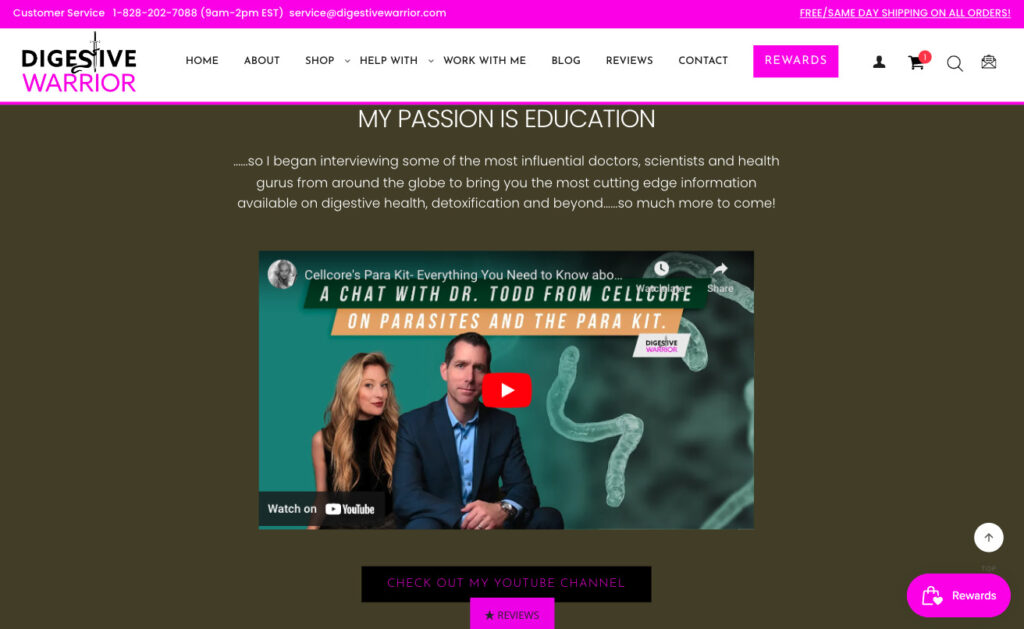
Source: digestivewarrior.com
Visitors Need Multiple Avenues to Reach Your Content
Google is and will probably always be the first place people search for information, inspiration, and products. According to PWC, 55% of consumers begin their buying journey on search engines (compared to 32% of people using social media for the same purpose).
But here’s the deal. Some of your articles — especially those that exist to support your sales process, frame your product, or generate authority for your brand — may not even rank on Google. Or even if they do, the search volume won’t be substantial enough to bring sufficient traffic to your site.
So, instead of waiting for your target audience to land on your content pages, take an active role in helping them discover your B2C content.
One way to do this is, of course, to use social media as a distribution platform. Something as basic as sharing links to new (and old) articles on your Twitter feed or Instagram Stories can be a valuable traffic source. Goodbudget employs this B2C content marketing strategy, using social networks to present followers with engaging content, provide customer support, and post product updates.

Source: twitter.com
However, it’s also a good idea to explore ways to use your website more efficiently in leading consumers toward content they’ll find valuable.
For instance, if you check out Going’s Cheap Flights from Anywhere landing page, you’ll see that the bottom section includes a host of content links. All of these lead to insightful articles made to appeal to people populating different stages of the buyer’s journey. And, seeing that the titles perfectly reflect Going’s audience’s wants, needs, priorities, and interests, it’s almost guaranteed that visitors will click on these links, consume the content, and increase their chances of becoming the brand’s customers.
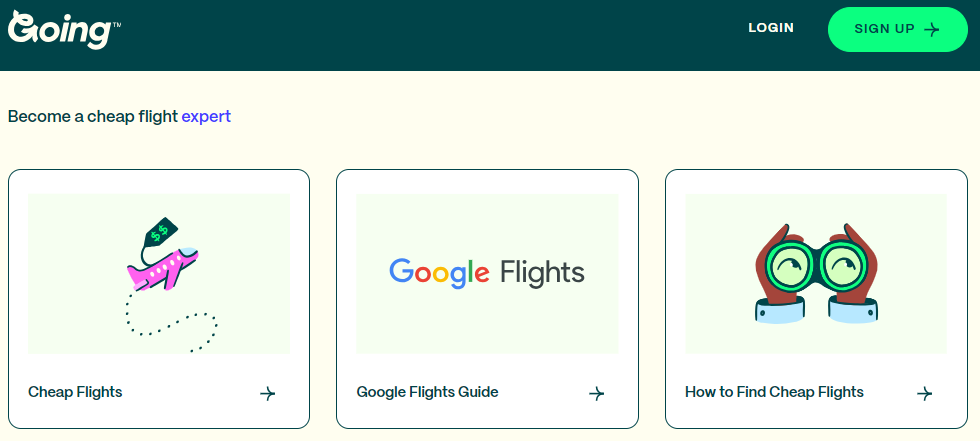
Source: going.com
Being Helpful Is More Important Than Pressuring a Sale
When producing B2C content that can potentially convert new customers, you need to strike the right balance between selling and helping.
Yes, boosting conversions is the ultimate goal of investing in any marketing strategy. That’s why you need to master using content to inspire sales (more on that later). Nonetheless, consumer psychology research shows that being too pushy doesn’t sell. On the contrary, experts agree that aggressive sales techniques may alienate your audience and cause you to lose their trust.
So, how can you avoid this faux pas in your B2C content marketing strategy?
Well, the best thing you can do is put your audience’s needs first. Do your best to help them solve their pain points — even if it means giving some of your insider knowledge away for free.
For example, if you check out the Inbox Zero Method 101 article on the Missive blog, you’ll see that the brand genuinely puts user value before sales. It provides web visitors with a 3,000-word post on achieving their desired effect. It also gives tips on how readers can reach inbox zero if they use one of the brand’s competitors’ products before moving on to actionable advice on using the Missive app for the same purpose.
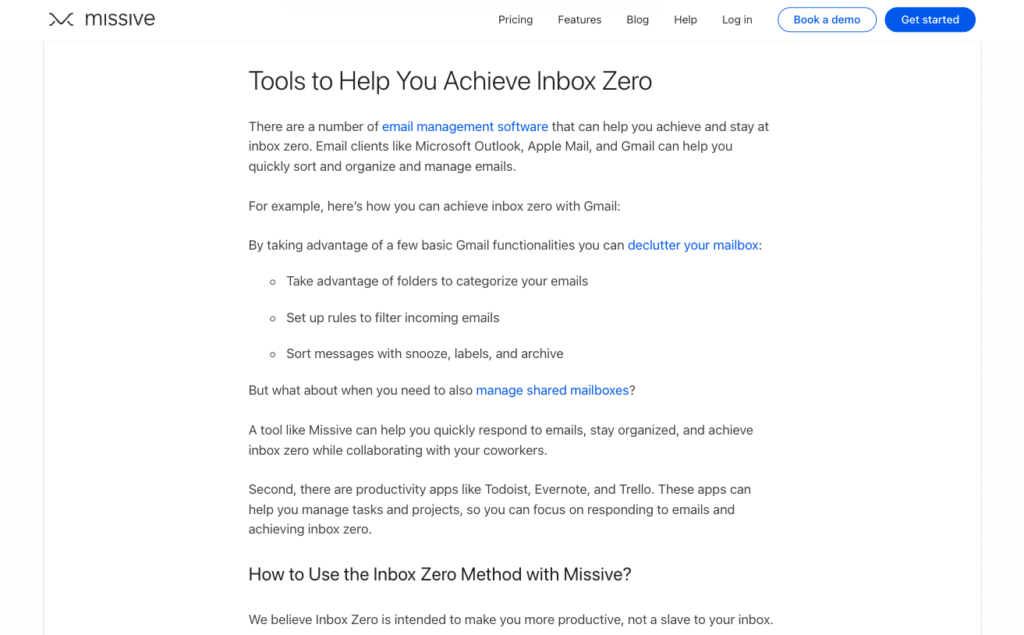
Source: missiveapp.com
While this approach to B2C content marketing may seem counterintuitive, remember that the point of this technique is to align your brand with being helpful.
Ultimately, consumers don’t want to give their hard-earned money to organizations “just because.” Research shows that 79% of people want brands to demonstrate that they understand and care about their audience’s needs and earn their customers’ trust and business. So, do your best to use content for that exact purpose.
Many of Your Readers Are Ready to Become Customers
Even though aggressive sales techniques tend to backfire, you have to understand that a portion of your audience — even if just a small one — will be ready to purchase after consuming your brand’s content for the first time.
According to a 2023 survey commissioned by Slickdeals, 35% of consumers make purchasing decisions on impulse. According to the survey results, the most common items people buy on impulse include clothing, groceries, household items, and shoes. The conclusion is that, except for food, today’s consumers see impulse shopping as something between a treat and a necessity.
So, how can you use this information to elevate your B2C content marketing efforts?
Knowing that many people are willing to spend money on items they believe will improve their lives, you can use available opportunities in your existing posts to allow them to do just that.
For example, you can include bold and obvious product links in your articles without compromising the informational value of the post. Transparent Labs does this in its Best Creatine Supplement article, and the approach works for several reasons.
For one, overt product links present a convenient way for readers to take action right after reading the resource. They can purposefully implement their newfound knowledge. But, more importantly, knowing that consumers often make emotionally-driven purchases, Transparent Labs supplements its inspirational article about the best products for building muscle mass with product links that will help readers achieve their health goals. This is especially effective, seeing how becoming healthier is one of consumers’ top priorities for 2023.
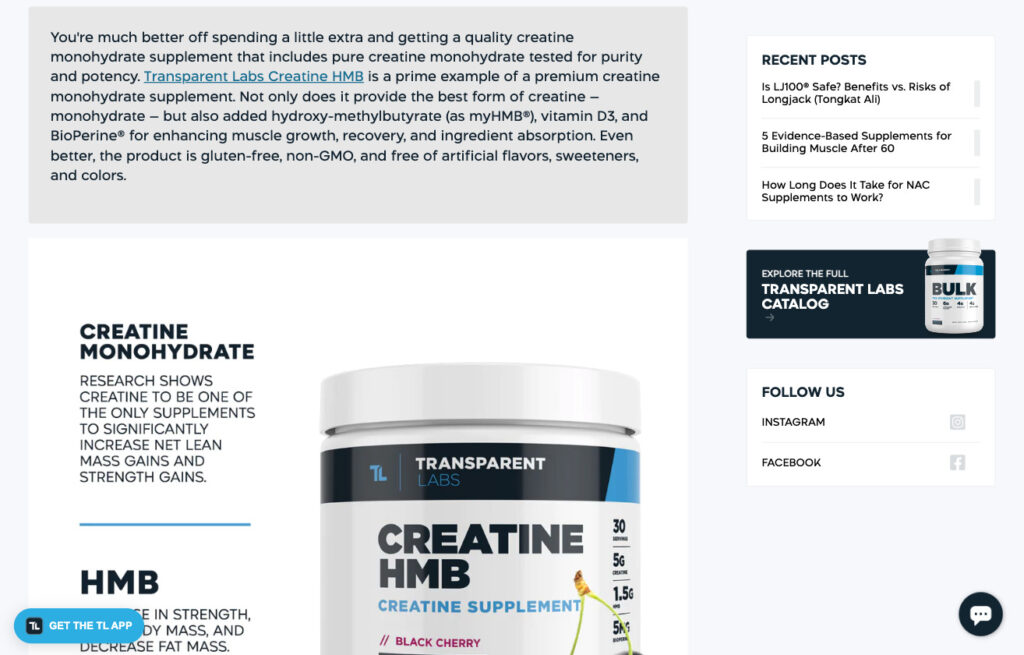
Source: transparentlabs.com
As you implement this principle of B2C content marketing, you must know who you’re writing for. Adding sales-oriented CTAs to your awareness-stage content may be a gamble relying on your readers’ preparedness to convert after a single touch. However, ensure you don’t make the mistake of failing to optimize your articles for user intent.
If a website visitor comes to your post expecting to find a guide on the Best Running Shoes for Flat Feet, you must include product links in a clearly visible manner, just like Runner’s World did in the example below. In this case, presenting readers with options without product links will only lead to frustration. It will cause your target audience to perceive your brand as unhelpful and ignore its content in the future.
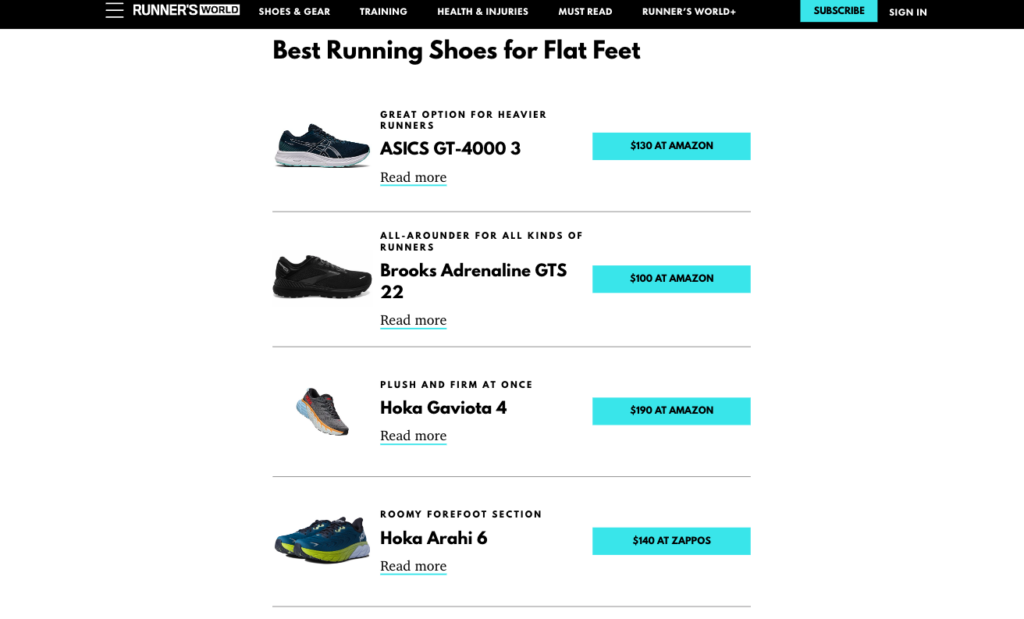
Source: runnersworld.com
A Large Portion of Your Target Audience Doesn’t Want to Read
Finally, as you explore the principles that drive B2C content marketing success, remember that today’s audiences don’t want to read online.
You’ve probably already heard that 80% of people don’t read online articles, scanning them for relevant information instead. But optimizing your content pages to be accessible, skimmable, and visually engaging is just the tip of the iceberg when creating successful content.
Research from the past few years consistently shows that the most effective format for attracting and retaining audience attention is video (more precisely, short-form video). Consumers still show interest in articles, customer stories, events, podcasts, and interactive tools. But unlike B2B audiences, they won’t be willing to invest as much time in the product evaluation process, meaning that long-form resources won’t be the ideal conversion-inspiring weapon in your arsenal.
This means that you need to produce and distribute B2C content that contains a dose of instant gratification and makes it super easy for your audience to extract value. And the easiest way to accomplish this is through snackable multimedia experiences.
For instance, repurposing long-form content into TikToks, Reels, or Shorts is an excellent way to grab consumer attention and encourage your audience to check out the full-length resource.
Similarly, if you can present your audience with educational content that isn’t in text format — the TikTok video below from Lords & Labradors is an excellent example — you’ll be far more likely to keep them engaged and gently nudge them toward making a purchase decision.

Source: tiktok.com
Wrapping Up
Ensuring you get the most out of your content marketing strategy hugely depends on whether you’re trying to convert professional users or end consumers. And even though the B2B journey may be more complex than its B2C counterpart, earning end consumers’ attention, trust, and loyalty is ultimately more difficult.
Fortunately, however, you can go a long way toward achieving success by implementing the six principles explored in this article. B2C content marketing aims to create resources that prioritize your target audience’s needs and satisfaction. And if you can do that, the conversions will follow.
Featured image by Pexels.









